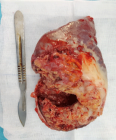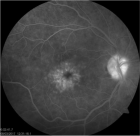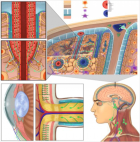Abstract
Case Report
Meige Trofoedema: A form of primary lymphedema
Carlos Al Sanchez Salguero*
Published: 24 April, 2018 | Volume 2 - Issue 1 | Pages: 010-014
The lymphatic system consists of small non-contractile lymph vessels which collect fluid from the interstitial space and carry it to the major contractile lymphatic vessels with valves that maintain a unidirectional flow to the lymph nodes and is responsible for returning proteins, lipids and water from the interstitium to the venous system near the junction of the subclavian vein and internal jugular vein on both sides. Lymphedema would be the result of the failure of transport with the further accumulation of fluid rich in protein at the interstitium, especially in limbs.
Primary lymphedema, which affects 1.15 / 100000 children (especially pre-pubescent girls), not always clinically evident at birth, is a genetic disorder that represents many different subsets of phenotypes: congenital or congenital lymphangiectasia, congenital trofoedema family or Meige, congenital amniotic band and essence or idiopathic.
The most common form of presentation is due to congenital absence or abnormality of the lymphatic tissue caused by a genetic mutation of the genes responsible for the development of lymphatic vessels that is characterized by the difficulty of draining lymph vessels. This genetic alteration may be sporadic or inherited.
Read Full Article HTML DOI: 10.29328/journal.acr.1001007 Cite this Article Read Full Article PDF
Keywords:
Lymphedema; Indirect radionuclide lymphoscintigraphy; Trofoedema; Meige´s disease
References
- Allevato MA, Bilevich DE. Linfedema. Act Terap Dermatol. 2008; 31: 294. Ref.: https://goo.gl/bYMfmp
- Tabel Y, Mungan I, Sigirci A, Gungor S. Prymary Lymphoedema at an unusual Location Triggered by Nephrotic Syndrome. Ann Acad Med Singapore. 2009; 38: 636-673. Ref.: https://goo.gl/9VXKc6
- Mortimer PS. The pathophysiology of lymphedema. Cancer. 1998; 15: 2798-2802. Ref.: https://goo.gl/gVaUey
- Smeltzer DM, Stickler GB, Schirger A. Primary lymphedema in children and adolescents: a follow-up study and review. Pediatrics. 1985; 76: 206-218. Ref.: https://goo.gl/8jRB9q
- Szuba A, Rockson SG. Lymphedema: classification, diagnosis and therapy. Vasc Med. 1998; 3: 145-156. Ref.: https://goo.gl/AbW7M5
- Blanco JM, Ruiz OC, Acedo MJM, Garcia EM, Gomez EF, et al. Linfedema primario. A propósito de un caso. Vox Paediatrica. 1999; 7: 36-38. Ref.: https://goo.gl/Dut7Rx
- Fischer M, Costanzo U, Hoffmann U, Bollinger A, Franzeck UK. Flow velocity of cutaneous lymphatic capillaries in patients with primary lymphedema. Int J Microcirc Clin Exp. 1997; 17: 143-149 Ref.: https://goo.gl/75VKuj
- Rezaie T, Ghoroghchian R, Bell R, Brice G, Hasan A. Primary non-syndromic lymphoedema (Meige disease) is not caused by mutations in FOXC2. Eur J Hum Genet. 2008; 16: 300-304. Ref.: https://goo.gl/haVUJP
- Dale RF. The inherirance of primary lymphoedema. J Med Genet. 1985; 22: 274-278. Ref.: https://goo.gl/EagFyX
- Wolfe JH. The prognosis and possible cause of severe primary lymphoedema. Ann Royal College Surg Engl. 1984; 66: 251-257. Ref.: https://goo.gl/sgwBgp
- Olmo JD, España A, Richter J. Utilidad de la linfogammagrafía isotópica en el estudio de linfedemas. Actas Dermo-sifiliograficas. 2005; 96: 419-423. Ref.: https://goo.gl/pMkjv6
- Fonkalsrud EW. Congenital malformations of the lymphatic system. Semin Pediatr Surg. 1994; 3: 62-69. Ref.: https://goo.gl/guB7qG
- Szuba A, Rockson SG. Lymphedema: classification, diagnosis and therapy. Vasc Med. 1998; 3: 145-156. Ref.: https://goo.gl/XxUQDB
- Browse NL. The diagnosis and management of primary lymphedema. J vasc Surg. 1986; 3: 181-184. Ref.: https://goo.gl/uetcui
- Huang A, Fruauff A, DiCarmine F, Schuss A, Losada R. Case report 861: Primary lymphedema of the left lower extremity. Skeletal Radol. 1994; 23: 483-485. Ref.: https://goo.gl/DK8gJs
- Yasuhara H, Shigematsu H, Muto T. A study of the advantages of elastic stockings for leg lymphedema. Int Angiol. 1996; 15: 272-277. Ref.: https://goo.gl/QdEZp1
- Ko DS, Lerner R, Klose G, Cosimi AB. Effective treatment of lymphedema of the extremities. Arch Surg. 1998; 133: 452-458. Ref.: https://goo.gl/CUFHFX
Figures:
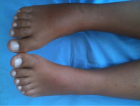
Figure 1
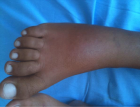
Figure 2
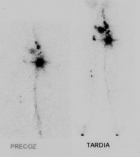
Figure 3
Similar Articles
-
Meige Trofoedema: A form of primary lymphedemaCarlos Al Sanchez Salguero*. Meige Trofoedema: A form of primary lymphedema. . 2018 doi: 10.29328/journal.acr.1001007; 2: 010-014
-
Lymphoscintigraphic Investigations for Women with Lower Limb Edemas After One PregnancyCallebaut Gregory,Leduc Olivier,Pierre Bourgeois*. Lymphoscintigraphic Investigations for Women with Lower Limb Edemas After One Pregnancy. . 2025 doi: 10.29328/journal.acr.1001129; 9: 066-072
Recently Viewed
-
Sinonasal Myxoma Extending into the Orbit in a 4-Year Old: A Case PresentationJulian A Purrinos*, Ramzi Younis. Sinonasal Myxoma Extending into the Orbit in a 4-Year Old: A Case Presentation. Arch Case Rep. 2024: doi: 10.29328/journal.acr.1001099; 8: 075-077
-
High-Performance Liquid Chromatography (HPLC): A reviewAbdu Hussen Ali*. High-Performance Liquid Chromatography (HPLC): A review. Ann Adv Chem. 2022: doi: 10.29328/journal.aac.1001026; 6: 010-020
-
Drug Rehabilitation Centre-based Survey on Drug Dependence in District Shimla Himachal PradeshKanishka Saini,Palak Sharma,Bhawna Sharma*,Atul Kumar Dubey,Muskan Bhatnoo,Prajkta Thakur,Vanshika Chandel,Ritika Sinha. Drug Rehabilitation Centre-based Survey on Drug Dependence in District Shimla Himachal Pradesh. J Addict Ther Res. 2025: doi: 10.29328/journal.jatr.1001032; 9: 001-006
-
Poly-dopamine-Beta-Cyclodextrin Modified Glassy Carbon Electrode as a Sensor for the Voltammetric Detection of L-Tryptophan at Physiological pHMohammad Hasanzadeh*,Nasrin Shadjou,Sattar Sadeghi,Ahad Mokhtarzadeh,Ayub karimzadeh. Poly-dopamine-Beta-Cyclodextrin Modified Glassy Carbon Electrode as a Sensor for the Voltammetric Detection of L-Tryptophan at Physiological pH . J Forensic Sci Res. 2017: doi: 10.29328/journal.jfsr.1001001; 1: 001-009
-
WMW: A Secure, Web based Middleware for C4I Interoperable ApplicationsNida Zeeshan*. WMW: A Secure, Web based Middleware for C4I Interoperable Applications. J Forensic Sci Res. 2017: doi: 10.29328/journal.jfsr.1001002; 1: 010-017
Most Viewed
-
Evaluation of Biostimulants Based on Recovered Protein Hydrolysates from Animal By-products as Plant Growth EnhancersH Pérez-Aguilar*, M Lacruz-Asaro, F Arán-Ais. Evaluation of Biostimulants Based on Recovered Protein Hydrolysates from Animal By-products as Plant Growth Enhancers. J Plant Sci Phytopathol. 2023 doi: 10.29328/journal.jpsp.1001104; 7: 042-047
-
Sinonasal Myxoma Extending into the Orbit in a 4-Year Old: A Case PresentationJulian A Purrinos*, Ramzi Younis. Sinonasal Myxoma Extending into the Orbit in a 4-Year Old: A Case Presentation. Arch Case Rep. 2024 doi: 10.29328/journal.acr.1001099; 8: 075-077
-
Feasibility study of magnetic sensing for detecting single-neuron action potentialsDenis Tonini,Kai Wu,Renata Saha,Jian-Ping Wang*. Feasibility study of magnetic sensing for detecting single-neuron action potentials. Ann Biomed Sci Eng. 2022 doi: 10.29328/journal.abse.1001018; 6: 019-029
-
Pediatric Dysgerminoma: Unveiling a Rare Ovarian TumorFaten Limaiem*, Khalil Saffar, Ahmed Halouani. Pediatric Dysgerminoma: Unveiling a Rare Ovarian Tumor. Arch Case Rep. 2024 doi: 10.29328/journal.acr.1001087; 8: 010-013
-
Physical activity can change the physiological and psychological circumstances during COVID-19 pandemic: A narrative reviewKhashayar Maroufi*. Physical activity can change the physiological and psychological circumstances during COVID-19 pandemic: A narrative review. J Sports Med Ther. 2021 doi: 10.29328/journal.jsmt.1001051; 6: 001-007

HSPI: We're glad you're here. Please click "create a new Query" if you are a new visitor to our website and need further information from us.
If you are already a member of our network and need to keep track of any developments regarding a question you have already submitted, click "take me to my Query."







